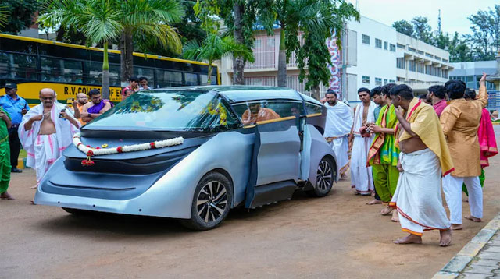A joint research project involving IT giant Wipro, the Indian Institute of Science (IISc), and students from RV College of Engineering (RVCE) has unveiled an indigenous, autonomous car prototype in Bengaluru. The breakthrough, aimed at conquering the chaotic and unpredictable nature of Indian roads, captured national attention after a video of a spiritual leader taking a test ride went viral on social media.
The self-driving vehicle, developed under the WIRIN (Wipro–IISc Research and Innovation Network) program, represents a significant leap in India’s pursuit of homegrown autonomous mobility technology.
The prototype, currently being tested at the RVCE campus, became a sensation when a video clip circulated showing Sri Satyatmatheertha Swamiji of the Uttaradi Matha, a revered spiritual leader, seated calmly inside the vehicle as it navigated the campus autonomously.
The sight of the seer taking a serene ride in a car powered by complex algorithms and sensors was quickly hailed online as a symbolic blend of India’s ancient traditions and its modern technological prowess. The test ride served as a powerful visual proof-of-concept for the team’s six years of dedicated development.
Unlike autonomous systems designed for the highly structured roads of the West, the WIRIN prototype is specifically engineered to handle the unique challenges of the Indian environment, including:
- Unpredictable Traffic: Navigating the dense, often chaotic mix of vehicles, pedestrians, and cyclists.
- Infrastructure Gaps: Detecting and avoiding deep potholes and sudden surface changes.
- Stray Animals: Utilizing custom AI and sensor fusion to identify and react safely to non-traditional road users like stray cows and dogs.
Wipro’s expertise in autonomous systems, combined with IISc’s deep research in AI, robotics, and machine learning, has allowed the team to develop custom computer vision algorithms trained on locally collected data.
The vehicle is still in the prototype stage, with teams now focused on extensive high-definition mapping and rigorous simulation testing. While the car is not yet ready for public deployment, the successful campus demonstration sends a clear signal that India’s engineering talent is actively shaping the future of mobility designed for its own unique context.







